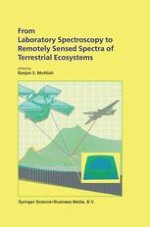2002 | OriginalPaper | Chapter
Carbon Sequestration from Remotely-Sensed NDVI and Net Ecosystem Exchange
Authors : E. Raymond Hunt Jr., J. T. Fahnestock, Robert D. Kelly, Jeffrey M. Welker, William A. Reiners, William K. Smith
Published in: From Laboratory Spectroscopy to Remotely Sensed Spectra of Terrestrial Ecosystems
Publisher: Springer Netherlands
Included in: Professional Book Archive
Activate our intelligent search to find suitable subject content or patents.
Select sections of text to find matching patents with Artificial Intelligence. powered by
Select sections of text to find additional relevant content using AI-assisted search. powered by
Aircraft eddy flux measurements of net ecosystem exchange were acquired in 1999 over four southeastern Wyoming landscapes: a coniferous forest, a mixed dryland/irrigated agricultural area, a mixed-grass prairie, and a sagebrush steppe. A linear relationship between net ecosystem exchange and the absorbed photosynthetically active radiation was used to determine the efficiency of radiation use, which was used with remotely-sensed normalized difference vegetation index to calculate gross primary production. Chamber measurements of total ecosystem respiration for the sagebrush and grassland sites were used to develop a functional relationship with daily average temperature. The sagebrush and forest sites were net carbon sinks, whereas the grassland and agricultural sites were in carbon balance. Combining the use of remote sensing with net ecosystem exchange measurements avoids problems associated with small-scale flux sampling to determine areas of carbon sequestration. With large areas of the globe covered by rangelands, the potential for carbon sequestration may be significant.
